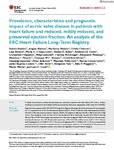Prevalence, characteristics and prognostic impact of aortic valve disease in patients with heart failure and reduced, mildly reduced, and preserved ejection fraction: an analysis of the ESC Heart Failure Long-Term Registry

Ver/
Use este enlace para citar
http://hdl.handle.net/2183/33275
A non ser que se indique outra cousa, a licenza do ítem descríbese como Creative Commons Attribution-NonCommercial 4.0 International License (CC-BY-NC 4.0)
Coleccións
- Investigación (FCS) [1293]
Metadatos
Mostrar o rexistro completo do ítemTítulo
Prevalence, characteristics and prognostic impact of aortic valve disease in patients with heart failure and reduced, mildly reduced, and preserved ejection fraction: an analysis of the ESC Heart Failure Long-Term RegistryAutor(es)
Data
2023-05-21Cita bibliográfica
Shahim B, Shahim A, Adamo M, Chioncel O, Benson L, Crespo-Leiro MG, Anker SD, Coats AJS, Filippatos G, Lainscak M, McDonagh T, Mebazaa A, Piepoli MF, Rosano GMC, Ruschitzka F, Savarese G, Seferovic P, Volterrani M, Crespo Leiro M, Segovia Cubero J, Amir O, Palic B, Maggioni AP, Metra M, Lund LH. Prevalence, characteristics and prognostic impact of aortic valve disease in patients with heart failure and reduced, mildly reduced, and preserved ejection fraction: an analysis of the ESC Heart Failure Long-Term Registry. Eur J Heart Fail. 2023 Jul;25(7):1049-1060.
Resumo
[Abstract] Aims: To assess the prevalence, clinical characteristics, and outcomes of patients with heart failure (HF) with or without moderate to severe aortic valve disease (AVD) (aortic stenosis [AS], aortic regurgitation [AR], mixed AVD [MAVD]).
Methods and results: Data from the prospective ESC HFA EORP HF Long-Term Registry including both chronic and acute HF were analysed. Of 15 216 patients with HF (62.5% with reduced ejection fraction, HFrEF; 14.0% with mildly reduced ejection fraction, HFmrEF; 23.5% with preserved ejection fraction, HFpEF), 706 patients (4.6%) had AR, 648 (4.3%) AS and 234 (1.5%) MAVD. The prevalence of AS, AR and MAVD was 6%, 8%, and 3% in HFpEF, 6%, 3%, and 2% in HFmrEF and 4%, 3%, and 1% in HFrEF. The strongest associations were observed for age and HFpEF with AS, and for left ventricular end-diastolic diameter with AR. AS (adjusted hazard ratio [HR] 1.43, 95% confidence interval [CI] 1.23-1.67), and MAVD (adjusted HR 1.37, 95% CI 1.07-1.74) but not AR (adjusted HR 1.13, 95% CI 0.96-1.33) were independently associated with the 12-month composite outcome of cardiovascular death and HF hospitalization. The associations between AS and the composite outcome were observed regardless of ejection fraction category.
Conclusions: In the ESC HFA EORP HF Long-Term Registry, one in 10 patients with HF had AVD, with AS and MAVD being especially common in HFpEF and AR being similarly distributed across all ejection fraction categories. AS and MAVD, but not AR, were independently associated with increased risk of in-hospital mortality and 12-month composite outcome, regardless of ejection fraction category.
Palabras chave
Aortic regurgitation
Aortic stenosis
Aortic valve disease
Ejection fraction
Heart failure
Mixed aortic valve disease
Aortic stenosis
Aortic valve disease
Ejection fraction
Heart failure
Mixed aortic valve disease
Versión do editor
Dereitos
Creative Commons Attribution-NonCommercial 4.0 International License (CC-BY-NC 4.0)
ISSN
1388-9842
Ítems relacionados
Mostrando ítems relacionados por Título, autor ou materia.
-
Blunt traumatic aortic injuries of the ascending aorta and aortic arch: a clinical multicentre study
Mosquera Rodríguez, Víctor Xesús; Marini Díaz, Milagros; Muñiz, Javier; Gulias, Daniel; Asorey-Veiga, Vanesa; Adrio-Nazar, Belén; Herrera, José M.; Pradas-Montilla, Gonzalo; Cuenca, José J. (Elsevier, 2012)[Abstract] Objective. To report the clinical and radiological characteristics, management and outcomes of traumatic ascending aorta and aortic arch injuries. Methods. Historic cohort multicentre study including 17 major ... -
Traumatic aortic injury score (TRAINS): an easy and simple score for early detection of traumatic aortic injuries in major trauma patients with associated blunt chest trauma
Mosquera Rodríguez, Víctor Xesús; Marini Díaz, Milagros; Muñiz, Javier; Asorey-Veiga, Vanesa; Adrio-Nazar, Belén; Boix, Ricardo; López-Pérez, José Manuel; Pradas-Montilla, Gonzalo; Cuenca, José J. (Springer, 2012-05-23)[Abstract] Purpose. To develop a risk score based on physical examination and chest X-ray findings to rapidly identify major trauma patients at risk of acute traumatic aortic injury (ATAI). Methods. A multicenter retrospective ... -
Epidemiology of acute traumatic aortic injuries in Galicia, Spain. Development and validation of a score for early diagnosis of aortic injuries in major blunt chest trauma patients and optimization of management algorithm
Mosquera Rodríguez, Víctor Xesús (Universidade da Coruña, 2012)Acute traumatic aortic injury (ATAI) usually occurs in patients with major blunt chest trauma and has devastating consequences. An early diagnosis with risk stratification, control of blood pressure and cardiac contractility ...






